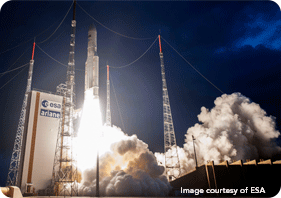MSG-4 blasts off successfully

On 15 July the fourth and last Meteosat Second Generation satellite (MSG-4), the eleventh in the Meteosat family, successfully lifted off from Europe’s Spaceport in Kourou, French Guiana.
MSG is a joint program of the European Space Agency (ESA) and EUMETSAT. ESA is responsible for the launch and initial operation phases, run from the European Space Operations Centre (ESOC) in Darmstadt, Germany. GMV is providing in situ support for the flight dynamic operations of this device, designed to facilitate the daily life of Europe’s citizens.
The MSG-4 satellite will monitor the earth’s climate from its geostationary orbit 36,000 km above the equator and at a longitude of 3.4º west. Weather forecasting services from all over Europe tap into Meteosat satellite images every 15 minutes.
Like its forerunners, MSG-4 includes a wide range of equipment and systems with cutting-edge technology. The heart of MSG-4 is the high resolution visible and infrared imager SEVIRI, a sophisticated radiometer that provides clean, updated images of the sky every 15 minutes. SEVIRI will observe for seven years, in the visible and infrared spectra, all the meteorological phenomena that occur over one third of the earth’s surface, taking in an area practically from the North Pole to the South Pole and from Chile to India.
Within ten days, at the end of the special operations, EUMETSAT will take over control of routine satellite operations. The SAFNWC (Satellite Application Facility for support to NoWCasting and very short range forecasting), a system integrated in the ground segment of the Meteosat satellite system (MSG: Meteosat Second Generation), will receive and process the MSG-SEVIRI data to generate the various meteorological products serving as support for very short range forecasting.
Since 1998 GMV has been providing the Spanish Meteorology Agency (Agencia Estatal de Meteorología: AEMET) with services for generation and maintenance of the MSG-related software package, taking on responsibility for engineering and system-integration activities as well as maintenance and support for end users.
GMV is also helping out in the development of MSG’s Meteorological Products Extraction Facility (MPEF) in EUMETSAT, a system for turning satellite data into the various meteorological products made available to EUMETSAT’s users.
ElMSG-4, becoming Meteosat-11 after commissioning, will act as a bridge between the 10th, launched in 2012, and the first Meteosat Third Generation (MTG) satellites, to be launched in 2019 and 2021, and in which GMV is also playing a key role.